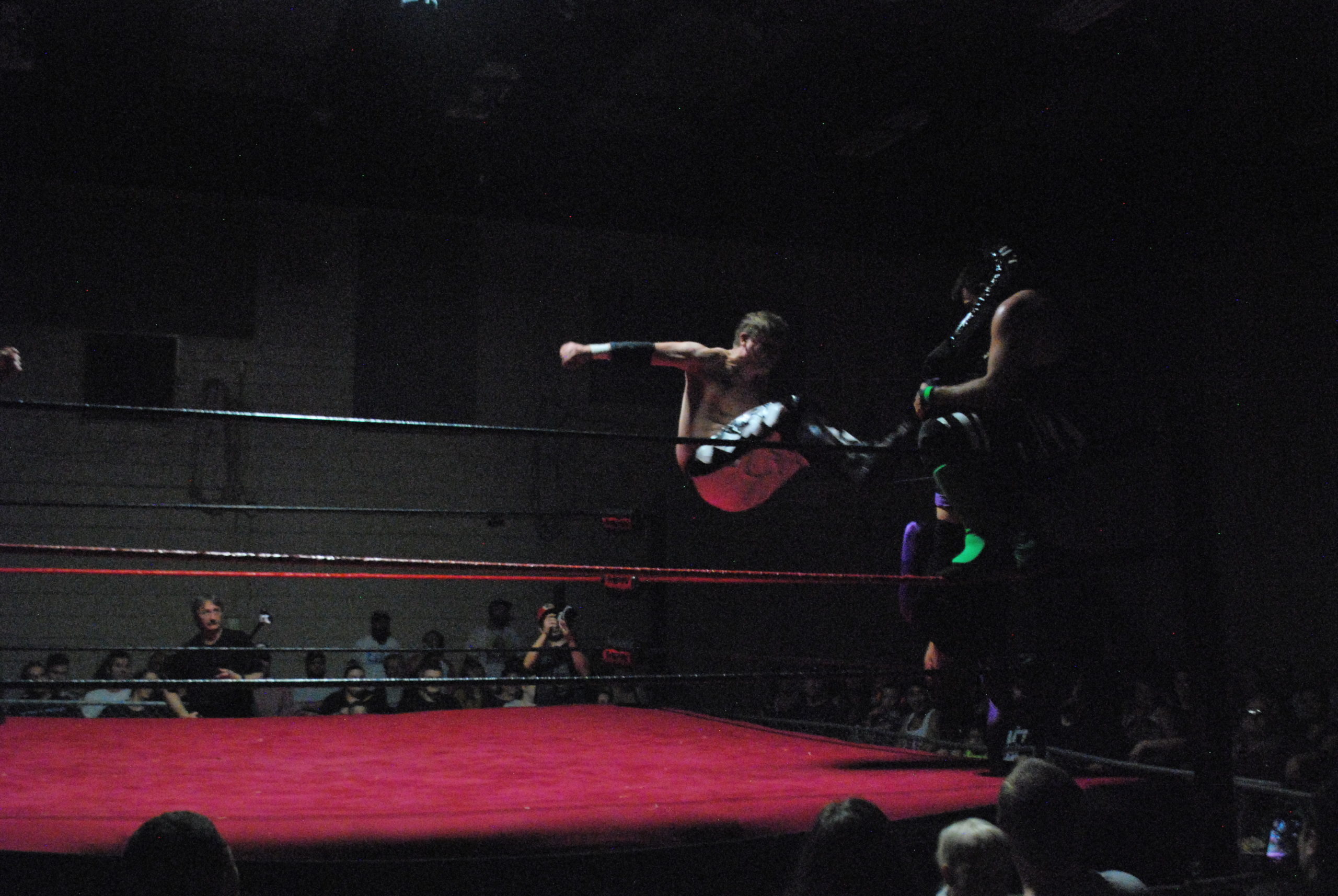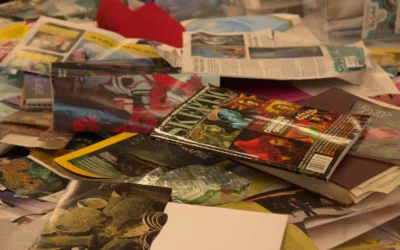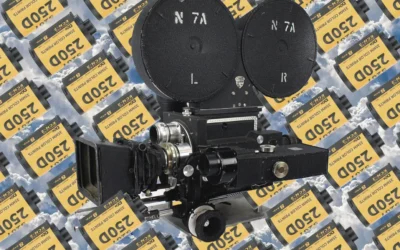Tucked into a quiet industrial park in the south-east corner of Edmonton, there is one dingy warehouse that does not house industrial goods as it was likely originally intended to. Rather, most of the space is taken up by a full-sized wrestling ring — stuffed into the long, skinny space, leaving barely enough room to walk by on either side. This is the training grounds of the independent, Edmonton-based wrestling promotion, Monster Pro Wrestling (MPW).
Upon walking into the building, I watch as two of the performers in the midst of that day’s training practice shoulder throws on each other. Both of them are in turn methodically slammed into the floor of the ring for several minutes while I wait for Sean Dunster, one of the founders of MPW, to finish signing up a new hire. He leads me upstairs to “the office” — a generous term for what actually amounts to a dark, musty, and nearly-empty room for the wrestlers to leave their gym bags in. On the way up, he tells me, “we’ve had quite a few new guys coming in recently. When (the Ultimate Fighting Championship) started becoming popular I think it took away from wrestling a bit but maybe now people are tired of watching two guys hug each other for an hour.”
He shows me a tiny side-room with walls hung with the black fabric used to film promotional videos, completing my tour of the facilities, and then we get to talking. It only takes a minute or two of listening to Dunster talk about his history with wrestling before I start to understand why his office has nothing in it: his work is done ring-side.

“My style is a very old-school wrestling style,” he says. “You watch any- where these days, you just don’t see the wrestling as much. I’m not saying it’s not there, or that guys aren’t talented, but you just don’t see it.”
“We have the word ‘wrestling’ in our name. It’s very important to me that we keep that in focus.”
Dunster himself has been wrestling since 1994, much of that time under the name “The Tattooed Terminator,” Massive Damage. In his early days, he was trained by famed World Wrestling Entertainment, Inc. (WWE) veteran Leo Burke, who is known in part for helping to launch the career of perhaps the most famous Canadian wrestler of all time: Bret Hart.
“I got a kick out of it because the two stayed good friends,“ says Dunster, “so when Bret left (the WWE), we were training right out of his house in Calgary, training with guys like Ken Shamrock, Mark Henry, and Andrew Martin.” All three of these examples went on to achieve fame with the WWE and other major leagues.

“My last three or four years I’ve just had a wicked influx of talent — hungry, young wrestlers that want to go places and try new stuff all the time.” — Sean Dunster
Dunster then spent “five or so years” touring the Maritimes with Real Action Wrestling, a promotion based out of Charlottetown, PEI, before deciding that what he really wanted to do was pass on his old-school fundamentals to the next generation of wrestlers, developing his own secret formula — which he bluntly dubbed the “wrestling success formula” — from refinements he made to Burke’s training. He moved back to Alberta in 2001, bought his own ring, and started up a wrestling school in Edmonton.
The way Dunster tells it, MPW transformed from just a school into a league of its own over time, as he, with the help of his head trainer Phil Lafon — another industry legend whose career has spanned Canada, the US, and Japan for almost 40 years — developed a regular roster of homegrown performers.
“We’re kind of just taking our first big steps now, 15 years later,” he says with a laugh. “My last three or four years I’ve just had a wicked influx of talent — hungry, young wrestlers that want to go places and try new stuff all the time.”

One such wrestler, “The Lumberjack” Larry Woods — named for his bushy beard, plaid shirts, and a signature move called “The Saw” — tells me, “Wrestling was a childhood dream of mine. My mom introduced me to it when I was about knee-high, and I’ve wanted to wrestle ever since.”
MPW still maintains its function as a school, holding regular introductory sessions to literally show people the ropes before they commit to getting suplexed on a weekly basis (for those interested, the next one is on Oct. 12 and 13, and will set you back $150). To Dunster, the company’s roots as a school are a major component in its ability to put on quality performances.

“I’ve got 20 of my own guys that I’ve trained, and I can specifically say to them ‘that’s not the way it’s done. I want it this way,’” he says. “They can work on their stuff right now, in the ring, while I’m doing this interview because I trust them because I know that they know what my style is.”
Indeed, the unmistakable thumps of bodies smacking into the canvas covering of the ring outside refuse to cease the entire time we speak. When we return to the training area, many of the other performers have shown up. The practice ring is now filled with wrestlers, spotting each other while attempting backflips or discussing the dynamics of upcoming matches — what the heel (the character that the audience is intended to dislike) could do to seem more villainous, and how the face (the character the audience is intended to cheer for) might respond, while Dunster shouts advice from the sidelines in a language completely inscrutable to an outsider like myself: “You don’t have to take a bump at the end of that spot! Don’t be afraid to just give him your three moves and then soak your corner and get out!” The session culminated in a mock tag team match — a trial run for a real match the crew had planned for their live show the following weekend.
“I actually wish I would’ve done a flip or something different, but I didn’t have much time to think about it.”
Phoenix
On event night, the old warehouse is abandoned in favour of the Alberta Avenue Community League, which is packed wall-to-wall with both regulars and curious newcomers, who are easily differentiated by the regulars’ near-constant chanting of pejorative nicknames they’ve collectively developed for the wrestlers they want to lose, and cheers of earnest support for those they want to win. In spite of its relatively small scale and budget, MPW’s show delivers on everything you might expect from pro wrestling — even if all you’ve watched are the big leagues like WWE. There are wacky characters with equally wacky costumes (one of the central villains of the night is a conniving Snidely Whiplash-like character named “Nasty” Nate Nixon), sensational storylines (the women’s championship match ended with both contestants teaming up against the referee, whom the crowd was continuously booing for reasons unknown to me), and, of course, the high-flying stunts that are undoubtedly painful in spite of being choreographed. Check out MPW’s Facebook page and one of the first things you’ll see is a clip from an event in August in which a wrestler, who requested to go by her stage name, Phoenix, dives off the roof of an 11-foot-tall moving truck.

“It looked like I was hesitating a bit, but it didn’t scare me,” she tells me. “I actually wish I would’ve done a flip or something different, but I didn’t have much time to think about it.”
The main event is a heavyweight title championship match that at multiple points devolves into a chaotic 15-person brawl on the sidelines. Larry Woods, the unequivocal good guy in this matchup, eventually wins to rousing cheers, only to be dramatically betrayed post-match by his very own Brutus: long-time ally “Danger Zone” Mitch Clarke, as the regulars sit in shock. To find out how this plays out, of course, they’ll have to show up again next time.
Monster Pro Wrestling puts on a show in the Alberta Avenue Community League building on the first Saturday of every month, as well as bi-monthly shows at Ellerslie Rugby Park.





0 Comments